John Quincy Adams
By
John T. Marck
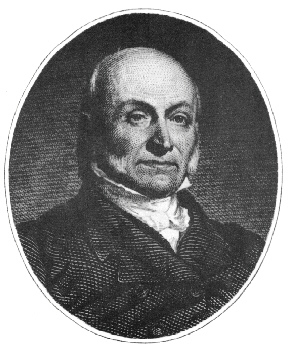
John Quincy Adams was born at the home of his parents known as "Peacefield," on July 11, 1767 in Braintree, now Quincy, Massachusetts. As a child, John Quincy watched the Battle of Bunker Hill from Penn=s Hill, above the family farm. He would become the first president of the United States who was the son of a president, his father John Adams. This fact of father and son as presidents did not occur again until George W. Bush was elected in 2000, the son of George H.W. Bush.
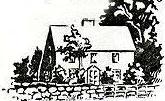
John Quincy graduated from Harvard College in 1787, after which he became a lawyer. At 26, he was appointed Minister to the Netherlands, and in 1802 was elected to the United States Senate. In 1808, President James Madison appointed him Minister to Russia. Later, under President James Monroe, John Quincy served as one of America=s great Secretaries of State. In this position he arranged with England the combined occupation of the Oregon Territory, obtained Florida from Spain, and assisted the President with the Monroe Doctrine. In his position as Secretary of State, John Quincy was thought of as heir to the Presidency.
In the 1828 election for the presidency, John Quincy was the candidate from the North, who fell behind General Andrew Jackson, in both popular and electoral votes. John Quincy did receive more votes than William H. Crawford and Henry Clay, his two other competitors. But, since no candidate had a majority of electoral votes, the election was decided among the top three by the House of Representatives. Henry Clay, who favored programs similar to those of Adams, placed his support in the House with him.
When John Quincy became President he, in many ways, paralleled the career and viewpoints of his famous father. He appointed Henry Clay as Secretary of State, which made Andrew Jackson angry, claiming that Adams had entered into what he called a "corrupt" bargain.@ So Jackson began his campaign in 1828 to oust the President.
Despite feelings of hostility by some members in Congress, Adams [in his first annual message] still presented an outstanding new program for the country. His proposal included bringing together a network of highways and canals, and that the government develop and conserve the public domain, using funds from the sale of public lands. This same year that Jackson started his campaign against him, Adams broke ground for the new 185-mile C&O Canal.
Adams also led the way in the development of the arts and sciences through the establishment of a national university, the financing of scientific expeditions, and the building of an observatory. Critics argued that these measures by Adams exceeded constitutional limitations.
Because of Jackson's campaigns against him he was defeated for a second term. Following his exit from the Presidency he returned to Massachusetts where he expected to retire and simply enjoy his farm and his extensive library of books.
Two years later, in 1830, he was unexpectedly elected to the House of Representatives, where he stayed and served for the remainder of his life. One of his main interests was fighting against the circumscription of civil liberties. With this in mind, in 1836, Congressmen from the South passed a "gag rule" that said that the House would automatically table any petitions against slavery. Fighting tirelessly against this, he finally obtained its repeal eight years later.
On February 21, 1848, he collapsed on the House floor from a stroke. He was carried to the Speaker=s Room, where, two days later on February 23, he died. He was buried at First Parish Church in Quincy, along with his wife, father and mother. John Quincy Adams, who was affectionately known as "Old Man Eloquent," spent his life fighting for what he considered right.
The Adams National Historic Site
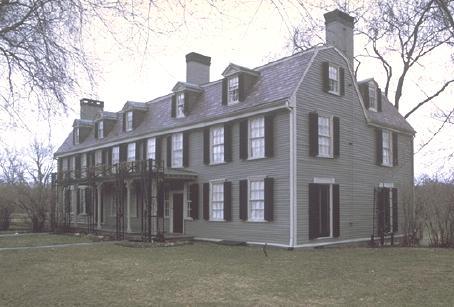
Today, the birthplaces of the Adams family are located in Adams National Historical Park, in Quincy, Norfolk County, Massachusetts, about ten miles south of Boston. This Park comprises eleven historic structures and a cultural landscape that totals fourteen acres.
Five generations of the Adams family lived here between 1720 and 1927 that included two Presidents and First Ladies, three U.S. Ministers, historians, and writers, as well as other members of the family that contributed to the success of those in the public eye.
John Adams, the second President, and his son, John Quincy Adams, the sixth President, both were born in adjacent houses on Franklin Street in Quincy, which at the time of their births was known as Braintree.
The main historic structure is the birthplace of John Adams, born October 30, 1735, and about 75 yards away, is the birthplace of his son, John Quincy. The house at 133 Franklin Street is a New England "saltbox" building with multiple fireplaces around a central chimney. Originally it consisted of two upper and two lower rooms, but more rooms were added to both floors. The house dates to about 1680 and thus is the oldest existing of all the Presidential birthplaces.
Upon his father=s death, John Adams (the future President) inherited a similar house next door that became his home and law office, and the birthplace of his son, John Quincy as well as the Massachusetts State Constitution. Both houses are typical of those built in the late 17th century by New England carpenters. The houses were framed with huge beams that were secured with wooden pegs, floored with wide planks, and covered with clapboard siding over brick-filled walls to help with the cold New England winters.
John Adams spent much of his time in Europe in his various diplomatic positions. During this time, his wife, Abigail, purchased, sight unseen, a farm and house less than two miles away from Franklin Street. Major Leonard Vassall, a wealthy West India sugar planter, had built this house in 1731.
Just as John Adams was preparing to settle into Peacefield, his new home, he was called away by George Washington to serve as his vice president. Thus, it would be twelve years before he would retire there, serving eight years with Washington, and another four as president. During the twelve years he was away, his wife Abigail was busy overseeing major improvements to the house that included doubling the capacity with an addition of an east wing in 1800. Years later, her great grandson Henry Adams recalled the following about the Old House:
"The Old House at Quincy known as Peacefield was 18th century. What style it had was its Queen Anne mahogany panels and its Louis XV chairs and sofa. The panels belonged to an old colonial Vassall who built the house; the furniture had been brought back from Paris in 1789 or 1801 or 1817, along with porcelain and books and much else of old diplomatic remnants; and neither of the two 18th century styles...was comfortable for a boy, or for anyone else. The dark mahogany had been painted white to suit daily life in winter gloom."
Finally at long last, John joined Abigail and he began to enjoy the gardens, his books, and his children and grandchildren. Over the years since he lived there, much has changed at Peacefield, but the present-day garden and beauty offer a link to the serenity of the earlier times. A white York rose brought to Peacefield from England in 1788 survived and still thrives today. As one walks the gravel paths through the orchards and gardens today give a renewed sense of the history, tradition and quietude of Peacefield.
Although John Quincy Adams loved the "Old House" and inherited it from his parents, he was too busy with politics to pay any attention to it. Consequently he left the supervision and maintenance of Peacefield to his son, Charles Francis Adams. In the middle of the 19th century, Charles converted the property from a farm to a country gentleman=s home and added a separate building, which became the Stone Library. It was here that John Adams=s extensive collections, consisting of 14,000 historic volumes as well as the collection that belonged to John Quincy, were kept.
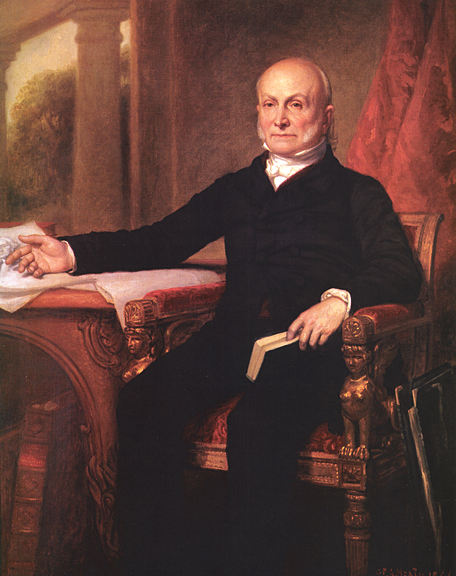
For generations, the Adams family remained in the "Old House," until 1927 when the Adams Memorial Society was formed and took possession of the home. In 1946 the Society deeded Peacefield to the federal government. The birthplaces of John and John Quincy, owned by the city of Quincy were also given to the federal government. These two areas, separated by less than two miles are today considered a single National Historic Site, controlled by the national Park Service. The Adams National Historic Site is open from April to November each year. A splendid time is guaranteed for all.
The United First Parish Church (Unitarian) Of Quincy is considered the finest existing Greek revival church in New England. The dominant interior feature is the decorative plaster dome. The church is the burial place of Presidents John and John Quincy Adams and their wives. John Quincy was instrumental in its erection in 1827‑28.
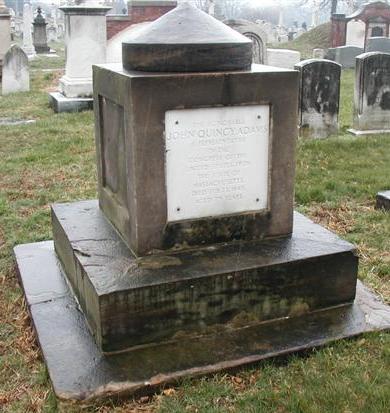
Quick Biographical Facts:
JOHN QUINCY ADAMS
6th President
Term- March 4, 1825 to March 4, 1829
Democratic-Republican Party
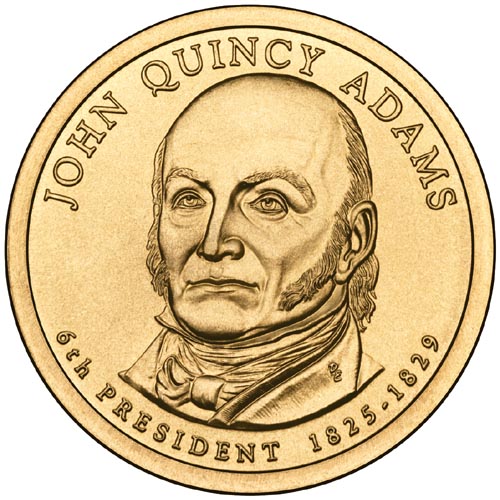
Birth: Braintree (Quincy) Massachusetts, July 11, 1767
Ancestry: English
Marriage: London, England, July 26, 1797 to Louise Catherine Johnson, (below) who was born in London, England, February 12, 1775. Louise died in Washington D.C., May 14, 1852 and is buried at First Parish Church, Quincy, Massachusetts.
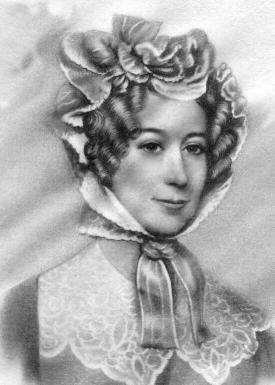
Children: George Washington (1801-1829); John (1803-1834); Charles Francis (1807-1886); Louisa Catherine (1811-1812).
Home: "Peacefield" Quincy, Massachusetts.
Education: Studied in Paris, Amsterdam, Leyden and The Hague; received B.A. (1787) from Harvard; and studied law (1788-1790) with Theophilus Parsons.
Religion: Unitarian
Occupation before Presidency: Lawyer, professor.
Pre-Presidential Offices: Minister to the Netherlands, Prussia, Russia, and Great Britain;
Member of the Massachusetts Senate; Member of U.S. Senate; Secretary of State.
Age at Inauguration: 57
Political Party: Federalist to 1808; Democratic-Republican to 1825; National Republican (Whig) thereafter.
Adams Administration: Vice-President: John Calhoun of South Carolina
Inauguration: March 4, 1825, Hall of the House of Representatives, Washington D.C.
Occupation after Presidency: Congressman, writer.
Death: Washington, D.C., February 23, 1848
Cause of Death: Stroke/Paralysis at age 80.
Place of Burial: First Unitarian Church, Quincy, Massachusetts.
Interesting Facts:
The first successful photograph ever made was taken in France in 1826, during Adams's Presidency.
Also during his Presidency, Noah Webster published his first dictionary in 1828, which contained 12,000 words
President Adams regularly swam nude in the Potomac River. Anne Royall, the first American professional journalist, knew of Adams' 5 A.M. swims. After being refused interviews with the president time after time, she went to the river, gathered his clothes and sat on them until she had her interview. Before this, no female had interviewed a president.
Adams was the first to be elected president without receiving either the most popular votes or the most votes of the Electoral College.
He was the first president married abroad.
Adams is the only president to be elected to the House after his presidency.
One of his sons, George Washington Adams, died at the age of 28, an apparent suicide

Copyright © John T. Marck. All Rights Reserved. This article and their accompanying pictures, photographs, and line art, may not be resold, reprinted, or redistributed for compensation of any kind without prior written permission from the author. Grateful appreciation and informational assistance from the Adams National Historic Park, Quincy, Massachusetts, and in part, from The Presidents of the United States by John T. Marck.
A Splendid Time Is Guaranteed For All
George Washington ( 30 APRIL 1789 - 03 MARET 1797)



